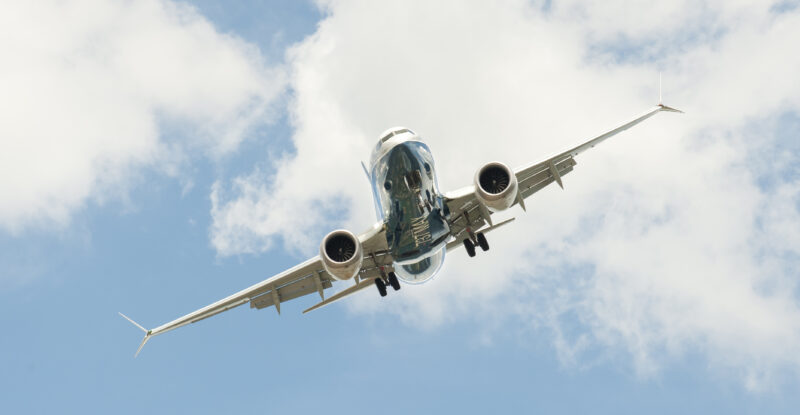Seeing strong momentum in its aerospace business, including in support of prominent commercial aircraft linefit and retrofit projects, Astronics Corporation is raising the lower end of its revenue guidance for 2025.
The East Aurora, New York-headquartered firm, which provides power, connectivity, lighting, interiors, structures and test solutions in civil aviation and defense, now expects to achieve revenue of approximately $840 million to $860 million for the year — up from its previous guidance of $820 million to $860 million.
Putting wind in Astronics’ sails, and indeed sales, is the fact that commercial aircraft production rates are trending upwards including on the Boeing 737 MAX program, for which Astronics provides exterior lighting, passenger service units (PSUs) and optional in-seat power.
The firm recently bolstered its monthly shipments for the MAX program and is on a “glide path” to support a rate in “the low 40s potentially by the end of the year if Boeing gets permission to go there,” Astronics chairman, president and CEO Peter Gundermann said during a conference call to report second quarter sales of $204.7 million, a 3.3% year-over-year increase driven by record aerospace segment sales.
Astronics also has large work packages on the Boeing 787 and is a supplier on the Airbus A350 and the A320 programs, the latter of which continues to ramp up towards a rate of 75 aircraft per month in 2027. To wit, it supports Airbus’ linefit, supplier-furnished HBCplus inflight connectivity program by providing both the Outside Aircraft Equipment (OAE) crown and the dual-modem MODMAN (modem manager) to support the Ka-band side of the program.
These aircraft programs, the 737, 787, A320 and A350, are the “four main ones” which have either seen production rate increases or are in line to do so when supply chain constraints are ironed out, Gundermann noted on the call.
Astronics is also a supplier on the Airbus A220 program in Montreal — it will provide the PSUs for the type — and this work “should be a pretty big driver as we move through 2026 so that’s a positive picture in general,” he said.
The retrofit side of the business also continues to be a “very positive place” for Astronics, which is a leading provider of in-seat power systems on commercial aircraft, including universal power outlets and USB ports, and is also able to support full cabin refreshes for airlines, including aircraft seat and IFE installations.
Said Gundermann:
We sit in a nice spot where consumer electronic lifecycles move on whether there’s a pandemic or not and in order to keep up with those shortened consumer electronic lifecycles, certain updates are necessary and certain modification efforts are necessary and when airlines do that, they generally do it across their fleet, both with new-build aircraft and with their existing fleet.
So, we’re continuing to see pretty strong opportunities there. It really hasn’t slowed down, even with the shortage of capacity out there in the airline fleet around the world, we’re pretty pleased with how that’s all going.
Astronics’ recent acquisition of Envoy Aerospace, an ODA with US FAA certification approval authority, is expected to be a “competitive differentiator” for the firm and will lessen retrofit program and schedule risk for both Astronics and its clients, he added.
Of note, following a competitive business review aided by an outside consulting firm, Astronics has taken a decision to step away from two aerospace segment product lines which management has concluded are “non-core” to the company’s future, namely satellite antennas and contract engineering & manufacturing programs.
“This simplification initiative resulted in $6.2 million of restructuring charges in the aerospace segment” during the second quarter, explained Gundermann. “These product lines have proven to be low growth and low margin, and the charges relate to write-down of inventory on certain facility assets.”
Through the years, Astronics has indeed provided antennas for the IFC market, including a traditional Ku-band gimbaled antenna (still in use at Delta Air Lines on certain widebodies) as well as a tail-mount solution for business aviation.
Its exit from antenna manufacturing, specifically, isn’t the biggest surprise, however. Amid a shifting market that sees Low Earth Orbit (LEO) constellations supporting IFC, including via LEO-only and hybrid multi-orbit LEO/GEO offerings, Astronics told Runway Girl Network last year that it was no longer pushing “any specific antenna technology.”
Gundermann shared color around that decision on the firm’s 2Q earnings call, saying:
The discontinuation of any further development of our satellite antenna line, which has been focused on large business jets and commercial transports operating with geosynchronous satellite constellations, was the result of having a low market share and recognition that conditions have slowed as customers contemplate emerging Low Earth Orbit constellations.
We decided that the investment in developing new antennas specific either to the LEO or GEO market would be too risky to justify the required financial investment.
But to be clear the antenna decision does not mean we’re walking away from LEO as a technology. To the contrary, the vast majority of our inflight entertainment and connectivity capabilities are as relevant to LEO networks as they are to GEO and to air to ground, ATG. The market is in a state of flux currently as customers consider the merits of competing technologies but we’re optimistic we can create value in the emerging LEO world as we have in the past with GEO and ATG.
Overall, despite certain tariff uncertainties, some supply chain bottlenecks and a 2Q decline in sales for its Test Systems business, Astronics forecasts a strong second half to 2025, as evidenced by its revised outlook.
Gundermann said the the firm expects to “enjoy the strong tailwinds prevalent in the industry, including increasing passenger traffic, aircraft utilization, aircraft build rates and the increased adoption of modern passenger entertainment and connectivity systems.”
Related Articles:
- How Astronics supports the evolving IFEC market, cabin mods
- Benefits of multi-orbit IFC explored at APEX TECH
- Kontron M&A ensures quiet giant has total ownership of systems
- Press Release: Astronics acquires FAA ODA services provider Envoy
- Press Release: Astronics launches SkyShow server with FlightPath3D
Featured image credited to istock.com/the_guitar_mann












